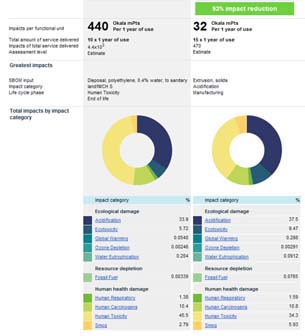Latest News
November 12, 2009
By Kenneth Wong
For the most part, when you launch your favorite mechanical modeling program, you’re thinking about shapes and forms, about extruded profiles and blended edges. If you plan to subject your model to stress test or finite element analysis (FEA), you might study your choice of materials, to ensure you select those with the right thermal and tensile properties so your 3D prototype can withstand the required temperature and load. But the rising interest in green products and the emergence of lifecycle assessment (LCA) tools may force you to look at materials in a whole new way.
The new currency in the green design movement is carbon. Unlike traditional currency, you want less of it, not more. The general principle is, the smaller your product’s carbon footprint, the better it is for the environment. As it turns out, your material selections for your parts can dramatically increase or decrease the carbon output of your product’s lifecycle.
The new approach may require you to strike a delicate balance, because industrial materials that perform best in FEA sometimes perform poorly in LCA. If you choose steel, your part can withstand a high degree of stress; on the other hand, because of the energy-intensive process to create steel, you’ll end up with a higher carbon count in your product’s lifecycle scorecard.
Early Carbon Detection
In SolidWorks 2010, an LCA module called Sustainability Xpress makes its debut. Developed in partnership with PE International, a sustainability consultant, the module appears under SolidWorks Evaluate tab, right alongside analysis tools. (For more, read “Sage Advice on Sustainability,” July 1, 2009, and watch the video report “A Look at SolidWorks Sustainability Xpress,” September 3, 2009.)
Because it’s integrated with your CAD system, the material you specify for your part (the tool currently works on individual parts only, not assemblies) is recognized by the software. So you won’t, for example, need to specify “Polycarbonate with high viscosity” for your FEA session, then do the same from a separate dialog box in the LCA module.
Based on your part’s geometry and a series of input (where the part is made, what manufacturing method is used, and where it’ll be used), the software calculates the expected environmental impact in four categories: carbon emission, fuel consumption, air pollution, and water pollution. With this quick rollup feature, you can compare different design versions, then (hopefully) pick the one with the lowest environmental impact.
If you happen to use Autodesk Inventor, your alternative might be Sustainable Minds, a Web-hosted LCA software that can interpret and accept a bill of materials exported from Autodesk Inventor. (For more, read “Sliding Into Sustainability,” November 9, 2009, and watch the accompanying video report in this issue.) The interoperability is made possible by a partnership between Autodesk and Sustainable Minds.
You can still use Sustainable Minds if you’re using another CAD package, but in that case, you’ll need to reformat your BOM to match Sustainable Minds’ BOM template before uploading it. The other option (which you’ll probably like to avoid if possible) is to enter your assembly BOM into Sustainable Minds’ setup manually, one item at a time.
Like SolidWorks Sustainability Xpress, Sustainable Minds give you a scorecard showing your part’s carbon output, among others. If you had provided distance of transportation involved (perhaps an estimate of how far the raw material needs to travel), end-of-life disposal method (incinerate, dump at landfill, or recycle), and manufacturing method, these become part of your carbon rollup and impact report.
 Fig 1. SolidWorks Sustainability Xpress offers a CAD-integrated life cycle assessment tool. |
Whereas SolidWorks Sustainability Xpress is embedded right into your 3D modeling environment, Sustainable Minds exists as a browser-based tool, apart from your CAD package. But Sustainable Minds lets you calculate the impact of your entire assembly, not just a part.
 Fig 2. Web-hosted software, Sustainable Minds lets you see the impact of your product in carbon count, toxicity, acidification, and human health hazard. |
Lack of Consensus
To calculate your product’s lifecycle impact, Sustainable Minds uses the Okala methodology, described as a system for “for evaluating potential ecological and human health impacts from products used in North America.”
Currently, no industry consensus exists on how LCA calculations should be made, so if you take a part with the same weight, volume, and material and tally up its carbon count in SolidWorks Sustainability Xpress and in Sustainable Minds separately, you probably won’t get the same numeric value, because the two software don’t factor in or weigh life cycle elements like transportation and manufacturing the same way.
In The Industrial Green Game (National Academies Press, 1997), Robert Johnston points out, “More recently, LCAs have attempted to include an assessment or impact analysis, which presents data from the analysis as a comparative index. These results are thus more subjective and require that relative weightings or importance scales be established … the rush to complete the assessment or impact stage is proceeding despite the difficulties associated with accurately analyzing the numbers in the first place.”
Results from SolidWorks Sustainability Xpress and Sustainable Minds should be treated as guidance for design improvement, not verification of actual carbon count.
Material Matters
The incorporation of LCA tools into CAD discipline may force designers to rethink what constitutes a product’s bill of materials (BOM). Traditionally, you consider BOM as a catalog of parts (part IDs, purchasing sources, dimensions, materials, and so on). But LCA requires you to consider not only what’s needed to make the product but what happens afterwards (the environmental impact of the disposal or recycling treatment available at the product’s end of life, which is limited by your material choices).
Debatable though their accuracy may be, LCA tools raise awareness of the environmental impact of certain materials, which require a large quantity of fossil fuel to produce. This could prompt a shift in the designers’ mindset. Going beyond testing a model’s form, fit, and function in analysis programs, many may now begin to weigh the strength of certain materials against the high cost of them on the environment.
Subscribe to our FREE magazine, FREE email newsletters or both!
Latest News
About the Author
Kenneth Wong is Digital Engineering’s resident blogger and senior editor. Email him at [email protected] or share your thoughts on this article at digitaleng.news/facebook.
Follow DE





